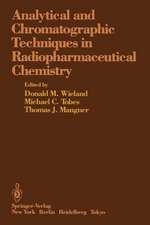Ambident Anions
Editat de O. Reutoven Limba Engleză Paperback – 8 feb 2012
Preț: 721.77 lei
Preț vechi: 759.76 lei
-5% Nou
Puncte Express: 1083
Preț estimativ în valută:
138.11€ • 144.20$ • 114.30£
138.11€ • 144.20$ • 114.30£
Carte tipărită la comandă
Livrare economică 05-19 aprilie
Preluare comenzi: 021 569.72.76
Specificații
ISBN-13: 9781461585848
ISBN-10: 1461585848
Pagini: 356
Ilustrații: XIV, 338 p.
Dimensiuni: 170 x 244 x 19 mm
Greutate: 0.57 kg
Ediția:Softcover reprint of the original 1st ed. 1983
Editura: Springer Us
Colecția Springer
Locul publicării:New York, NY, United States
ISBN-10: 1461585848
Pagini: 356
Ilustrații: XIV, 338 p.
Dimensiuni: 170 x 244 x 19 mm
Greutate: 0.57 kg
Ediția:Softcover reprint of the original 1st ed. 1983
Editura: Springer Us
Colecția Springer
Locul publicării:New York, NY, United States
Public țintă
ResearchDescriere
The importance of ambident reactivity in synthetic and mecha nistic organic chemistry cannot be overemphasized. It is therefore all the more frustrating that the breadth and diffuseness of the subject make the retrieval of information from the primary literature a difficult and onerous task, especially for the researcher who wishes to gain an overview of the factors influencing ambident behavior or an in-depth knowledge of the reactivity of a specific ambident system. The present volume is an attempt to meet these needs, at least as far as ambident anions are concerned. As a reference work combining under one cover an account of the factors underlying ambident behavior, a survey of the chemistry of the most important ambident anions (with especial emphasis on enolates), and a comprehensive compilation of recent key references, important but less well known citations from the nineteenth and early twentieth century literature, and relatively inaccessible data from the Soviet literature, this translation goes some way to filling a conspicuous gap in the mono graph literature of an important facet of organic chemical reactivity.
Cuprins
1. Introduction.- 1.1 Classification of Ambident Anions.- 1.2 Factors Controlling the Reactivity of Ambident Anions.- 1.3 Reaction Mechanisms Involving Ambident AnionParticipation.- 2. Enolate and Phenolate Ions.- 2.1 Structure of Alkali Enolates and Phenolates andthe Effect of the Nature of the Cation on theOrientation of Alkylation and Acylation.- 2.2 Effect of the Solvent.- 2.3 Effect of the Nature of the Electrophilic Agent.- 2.3.1 Effect of the Alkyl Group.- 2.3.2 Effect of the Leaving Group.- 2.4. Acylation of Metallic Derivatives of CarbonylCompounds.- 2.5 Silylation, Germylation, and Stannylation ofMetallic Derivatives of Keto-Enol Systems.- 2.6 Effect of the Nature of the Ambident Anion.- 2.7 Stereochemistry of Enolate Ion Alkylation.- 2.8 Effect of Ionic Association on Rate and Orientationof Enolate Ion Alkylation.- 3. Nitrite Ion.- 3.1 Nitro and Nitrito Complexes.- 3.2 Alkylation of Silver Nitrite.- 3.2.1 Stereochemistry and Mechanism of theMeyer Reaction.- 3.3 Alkylation of Alkali Metal Nitrites.- 3.4 Nitrite Ion in Aromatic Nucleophilic SubstitutionReactions.- 4. Anions of Nitro Compounds.- 4.1 O-Alkylation of Salts of Nitro Compounds.- 4.2 Acylation of Salts of Nitro Compounds.- 4.3 C-Alkylation of Nitroalkane Salts.- 4.4 C-and O-Alkylation and Acylation of Salts ofPolynitro Compounds.- 5. Cyanide, Cyanate, and Thiocyanate Ions.- 5.1 Structure of Metal Cyanides, Cyanates andThiocyanates.- 5.2 Cyanide Ion.- 5.3 Thiocyanate Ion.- 5.4 Cyanate Ion.- 6. Ambident Anions of Heterocyclic Compounds.- 6.1 Effect of the Nature of the Counterion and theSolvent in Alkylation.- 6.2 Effect of the Nature of the Alkylating Agent.- 6.3 Acylation of Pyrrolyl and Indolyl Anions.- 6.4 Alkylation of 2-Pyridone and 2-HydroxypyrimidineAnions.- 7. Other Ambident Systems.- 7.1 Oximate Ion.- 7.2 Diazotate Ion.- 7.3 Sulfinate and Sulfenate Ions.- References.- 1.- 2.- 3.- 4.- 5.- 6.- 7.

























